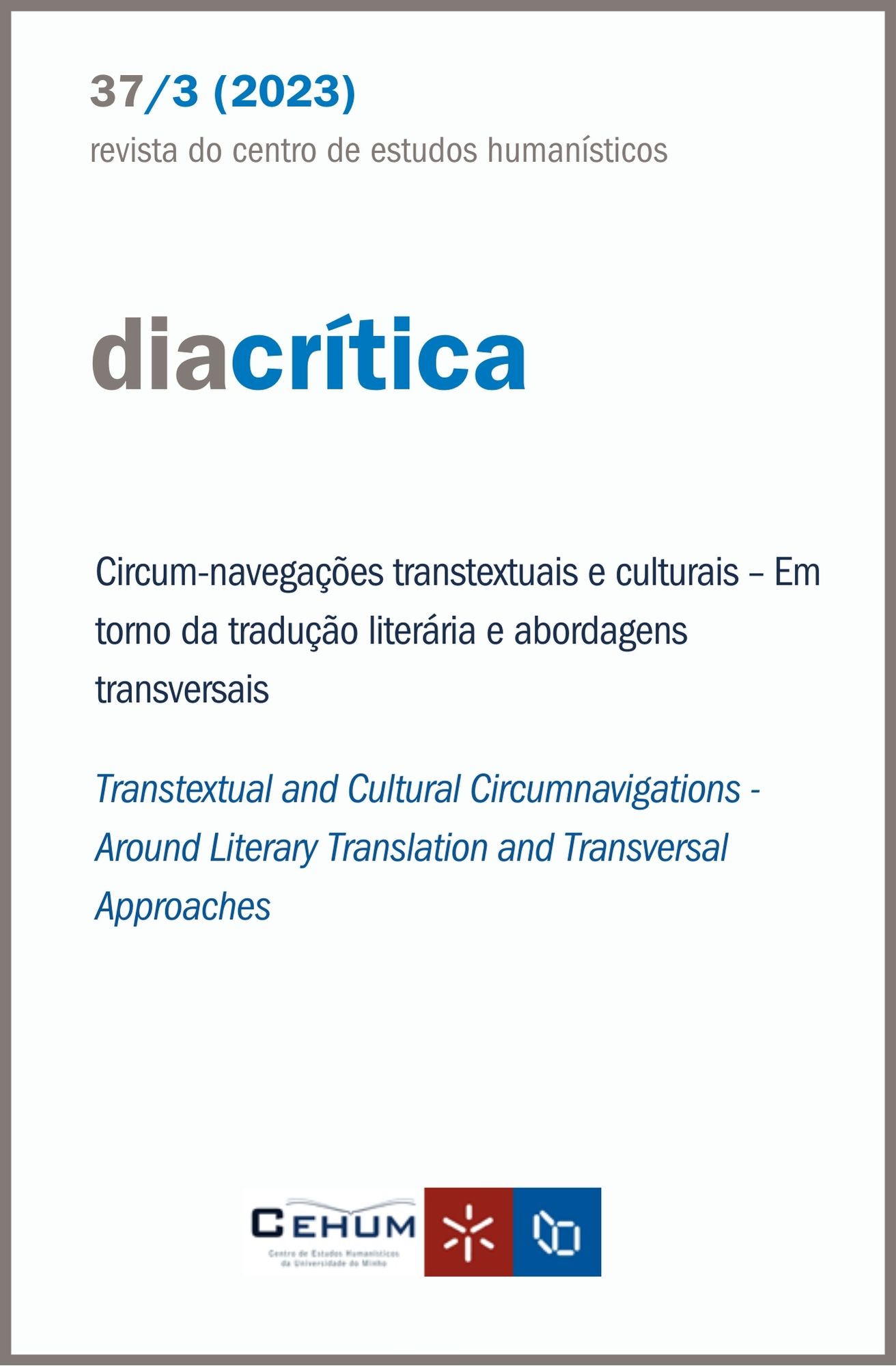Murder and translation considered as two of the Fine Arts
DOI:
https://doi.org/10.21814/diacritica.4953Keywords:
Murder, Translation, Fine arts, Thomas de Quincey, Robert Southey, Frank DrakeAbstract
Thomas de Quincey (1785-1859) was an early 19th century English writer and a genius of the most provocative humour that the brilliant romanticism of his nation has offered to the Universal Republic of Letters. In Spanish, his two most scandalous little books, because they were the most popular, were given the following titles: Los placeres y las tormentas del opio, from the original of 1821 (Confessions of an English Opium Eater), and El asesinato, considerado como una de las bellas artes, from the original of 1832 (On Murder Considered as One of the Fine Arts). If murder in the British Isles could be considered one of the fine arts, as his fellow countrywoman and successor Dame Agatha Christie (1890-1976) would perhaps demonstrate years later, how could we not use the same metaphor for the Spanish translations: the reception of humour and double entendres, the social criticism, the aesthetic-revolutionary approach, the manipulation of the rules of translation, intentions and even laws of translation, the change of functions, etc., etc., etc. Perhaps it is not possible to search for a more accurate text than the one we propose for this communication, to discover once again that certain translations, at least, are an artistic product, even if the perfect translation does not exist, as, some say, neither does the perfect crime, no matter how beautiful and macabre it may be.
References
Alonso-Cortés, C. D. (1981). Anatomía de Agatha Christie. Knossos.
Alvstad, C., & Assis Rosa, A. (2015). Voice in retranslation. An overview and some trends. Target, 17(1), 3–24. https://doi.org/10.1075/target.27.1.00int DOI: https://doi.org/10.1075/target.27.1.00int
Andreazza, F. (2018). Canudo et le cinéma. Nouvelles éditions Place. https://doi.org/ 10.7202/1053852ar
Anónimo. (1979). Amadís de Gaula. Novela de Caballerías, modernizada y prologada por Ángel Rosenblat (7.ª ed.). Editorial Losada. (original publicado en 1963)
Anonymous. (1803). Amadis of Gaul (R. Southey, Trad.). T. N. Longman and O. Rees.
Barriobero y Herrán, E. (ca. 1920). Prólogo. En T. De Quincey, Del asesinato, considerado como una de las bellas artes (E. Barriobero y Herrán, Trad.) (pp. 5–11). Editorial Mundo Latino.
Batteux, C. (1746). Les Beaux-Arts réduits à un même principle. De l’Imprimeire de Ch. J. B. Delspine, ed.
Canudo, R. (1995). Manifeste des sept arts. Séguier. (original publicado en 1911)
Capote, T. (1966). In cold blood: A true account of a multiple murder and its consequences. Random House.
Delacroix, E. (1999). Diccionario de las bellas artes (M. Etayo Gordejuela, Trad.). Editorial Sintesis.
De Quincey, T. (ca. 1920). El asesinato, considerado como una de las bellas artes (E. Barriobero y Herrán, Trad.). Editorial Mundo Latino.
De Quincey, T. (1906). The works of Thomas de Quincey. 1. Confessions of an English opium eater. Oxford University Press. (original publicado en 1821)
De Quincey, T. (1907). Reminiscences of the English lake poets. J. M. Dent & Sons. (original publicado en 1834–1840)
De Quincey, T. (1925). On murder considered as one of the fine arts. Philip Allan. (original publicado en 1827) DOI: https://doi.org/10.1093/oseo/instance.00238186
De Quincey, T. (2008). Del asesinato considerado como una de las bellas artes (D. Ruiz Rodríguez, Trad.). Ediciones Espuela de Plata. (original publicado en 1907)
De Quincey, T. (2022). On murder considered as one of the fine arts. Being an address made to a gentleman’s club concerning its aesthetic appreciation. Amazon Italia. (original publicado en 1827–1839) DOI: https://doi.org/10.1093/oseo/instance.00238316
Dotoli, G. (1999). Ricciotto Canudo: Ou le cinéma comme art. Didier Érudition.
Drake, F. D. (1968). Intelligent life in space. Macmillan.
Drake, F. D. (1993). Is anyone out there? Souvenir Press.
Esquerra, R. (1937). Shakespeare a Catalunya. Institució del Teatre / Generalitat de Catalunya.
Essop, A. (2002). Narcissus and other stories. Ravan Press.
García Reyes, A. (2022, junio 8). El duende de Nadal. Es uno de los elegidos por la historia para convertir el deporte en una de las bellas artes. Diario ABC, 7.
Garrido, V. (2021). True crime. La fascinación del mal. Ariel.
Gentzler, E. (2014). Translation studies: Pre-Discipline, discipline, interdiscipline, and post-discipline. International Journal of Society, Culture, and Language (IJSCL), 2(2), 13–24.
Keppler, V. (1938). The eighth art. A life of color photography. William Morrow & Co.
Mathijssen, J. W. (2007). The breach and the observance. Theatre retranslation as a strategy of artistic differentiation, with special reference to retranslations of Shakespeare’s Hamlet (1777-2001). Doctoral Thesis. University of Utrecht.
Shakespeare, W. (1908). Macbeth (D. Ruiz Rodríguez, Trad.). E. Domènech.
Toury, G. (2012). Descriptive translation studies – and beyond. John Benjamins. (original publicado en 1995) DOI: https://doi.org/10.1075/btl.4
Trabado Casado, J. M. (ed.) (2013). La narracción gráfica. Poética del noveno arte. Arco Libros.
Venuti, L. (2008). The translator’s invisibility. A history of translation. Routledge. (Original publicado en 1995)
Venuti, L. (2004). Retranslation: The creation of value. Bucknell Review, 47(1), 25–38. DOI: https://doi.org/10.1080/08956308.2004.11671660
Zarandona, J. M. (1993). De Quincey y un análisis del personaje de Henry V de William Shakespeare. Brispania, II, 143–174.
Zarandona, J. M. (1992–1994). Robert Southey: Hispanista y traductor de obras clássicas castellanas medievales. Revista de Investigación. Filología, XII(1), 7–27.
Zarandona, J. M. (2021). Argon Valley, the South African utopia of Ahmed Essop (1931–), or reflections on why the story “The pagans” will never be translated into Spanish. En V. Luarsabishvili (Ed.), Migration and society. Literature, translation, film (pp. 22–44). New Vision University Press.
Downloads
Published
How to Cite
Issue
Section
License
Copyright (c) 2024 Juan Miguel Zarandona

This work is licensed under a Creative Commons Attribution-NonCommercial 4.0 International License.










